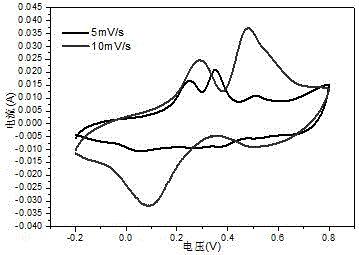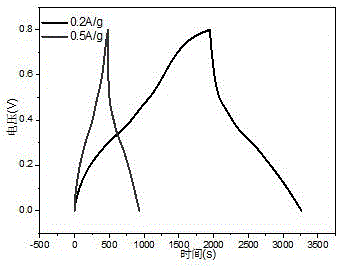Method for preparing conductive polyaniline nanotube by taking sucrose as template
A conductive polyaniline and nanotube technology, applied in nanotechnology and other directions, can solve the problems of affecting the electrochemical performance of polyaniline, uncontrollable and irregular diameter of polyaniline nanotubes, etc., and achieve high specific capacitance and cost. Low cost and the effect of reducing internal resistance
- Summary
- Abstract
- Description
- Claims
- Application Information
AI Technical Summary
Problems solved by technology
Method used
Image
Examples
Embodiment 1
[0014] (1) Weigh 0.250g of sucrose (the ratio of sucrose to aniline is 1:15), add it into a flask filled with 30mL deionized water, stir at room temperature for 0.5h, then transfer the flask to an ice water bath At this time, add 1 mL of purified aniline and 10 mL of 1 mol / L hydrochloric acid solution into the flask, and stir for 1 h under the condition of an ice-water bath.
[0015] (2) Dissolve a certain amount of ammonium persulfate in deionized water to obtain an aqueous solution of ammonium persulfate (the ratio of the amount of ammonium persulfate to aniline is 1:1), and then add it dropwise to step (1) The prepared solution was stirred for 12 hours under the condition of an ice-water bath. After the reaction was completed, the reactant was washed with deionized water and suction filtered until the filtrate was neutral. The obtained filter cake was stored in a vacuum oven at 50°C. Dry for 24 hours, grind and collect to obtain conductive polyaniline nanotubes.
Embodiment 2
[0017] (1) Weigh 0.313g of sucrose (the ratio of sucrose to aniline is 1:12), add it into a flask filled with 30mL deionized water, stir at room temperature for 0.5h, then transfer the flask to an ice water bath At this time, add 1 mL of purified aniline and 10 mL of 1 mol / L hydrochloric acid solution to the flask, and stir for 1 h under the condition of an ice-water bath.
[0018] (2) Dissolve a certain amount of ammonium persulfate in deionized water to obtain an aqueous solution of ammonium persulfate (the ratio of the amount of ammonium persulfate to aniline is 1:1), and then add it dropwise to step (1) The prepared solution was stirred for 12 hours under the condition of an ice-water bath. After the reaction was completed, the reactant was washed with deionized water and suction filtered until the filtrate was neutral. The obtained filter cake was stored in a vacuum oven at 50°C. Dry for 24 hours, grind and collect to obtain conductive polyaniline nanotubes.
Embodiment 3
[0020] (1) Weigh 0.417g of sucrose (the ratio of sucrose to aniline is 1:9), add it into a flask filled with 30mL deionized water, stir at room temperature for 0.5h, then transfer the flask to an ice water bath At this time, add 1 mL of purified aniline and 10 mL of 1 mol / L hydrochloric acid solution to the flask, and stir for 1 h under the condition of an ice-water bath.
[0021] (2) Dissolve a certain amount of ammonium persulfate in deionized water to obtain an aqueous solution of ammonium persulfate (the ratio of the amount of ammonium persulfate to aniline is 1:1), and then add it dropwise to step (1) The prepared solution was stirred for 12 h under the condition of an ice-water bath, and after the reaction was completed, the reactant was washed with deionized water and suction filtered until the filtrate was neutral. Finally, the filter cake was dried in a vacuum drying oven at 50° C. for 24 hours, and collected by grinding to obtain conductive polyaniline nanotubes.
PUM
 Login to View More
Login to View More Abstract
Description
Claims
Application Information
 Login to View More
Login to View More - R&D
- Intellectual Property
- Life Sciences
- Materials
- Tech Scout
- Unparalleled Data Quality
- Higher Quality Content
- 60% Fewer Hallucinations
Browse by: Latest US Patents, China's latest patents, Technical Efficacy Thesaurus, Application Domain, Technology Topic, Popular Technical Reports.
© 2025 PatSnap. All rights reserved.Legal|Privacy policy|Modern Slavery Act Transparency Statement|Sitemap|About US| Contact US: help@patsnap.com


